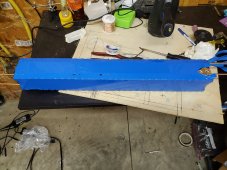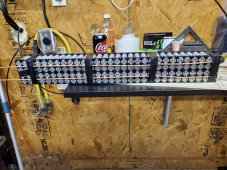Hello. Even it does not look difficult at the first look, i get confused with some choices in my first attempt to build a battery myself.
I need to make a storage for 12V system in my home on wheels to go on a prolonged journey through Europe starting soon..
I have 33 Yuasa (can get more) LEV46 SD Li-Ion cells with maximal voltage of 4.2Volts and rated at 46Ah each which tests to 99% capacity.
It will be charged by Victron Smart Slar controller with 50A (700W at 12v or 1400W at 24v)rating.
And i have the old (originally installed) AC-DC block that was designed to charge the 12V lead leisure battery and which is integrated in feeding of the 220v to system as well when connected. it seems to do its job well so far So i do not want to rebuild that part and keep it as is as it is already wired to all the switches in the panel.
And i would probably need a AC/DC charger separate for the battery, which i am willing to invest in as well.
I see 3 options:
1. make it 3S which means max voltage is 12.15V and it is about 80-85% and most appliances will cut off when the battery reaches it 25% level at ca 10.6V
2. make it 4S IF there is a solution to have the battery charged at 16.2V but feed to the system max 13.8V - this would make a higher voltage that the appliances are more stable with than sub 12V. and the second benefit in my view is that i would not have to think about separating the current AC/DC charger as well as the alternator as i can let them charge the battery up to 14.2 volts without a worry.
3. make it 6S and use a 24/12v DC/DC connected to a 12v deep discharge led battery - this again would let me not to worry about the integration of battery into current 12v system as it is a led battery that all appliances are connected to and which in turn is fed by the 24v storage constantly (While it has juice off course) . also no need for a high current DC/DC as if the demand spike over the dc/dc rating lead battery acts as a buffer.
Also this way would let me install one more solar panel as for the 24v system i can have up to 1400W
Also a benefit with this scenario is possibility to use a 24v AC inverter.
now, my mind is not wired electrically but rather i am looking for the most practical solution to use the maximum that my batteries can offer (up to 85% charge to 25% discharge) for the longest period of time.
If you have the experience or knowledge and some spare minute please share with me which way would you do this and why as i am also interested to understand why i will be doing what i will.
I need to make a storage for 12V system in my home on wheels to go on a prolonged journey through Europe starting soon..
I have 33 Yuasa (can get more) LEV46 SD Li-Ion cells with maximal voltage of 4.2Volts and rated at 46Ah each which tests to 99% capacity.
It will be charged by Victron Smart Slar controller with 50A (700W at 12v or 1400W at 24v)rating.
And i have the old (originally installed) AC-DC block that was designed to charge the 12V lead leisure battery and which is integrated in feeding of the 220v to system as well when connected. it seems to do its job well so far So i do not want to rebuild that part and keep it as is as it is already wired to all the switches in the panel.
And i would probably need a AC/DC charger separate for the battery, which i am willing to invest in as well.
I see 3 options:
1. make it 3S which means max voltage is 12.15V and it is about 80-85% and most appliances will cut off when the battery reaches it 25% level at ca 10.6V
2. make it 4S IF there is a solution to have the battery charged at 16.2V but feed to the system max 13.8V - this would make a higher voltage that the appliances are more stable with than sub 12V. and the second benefit in my view is that i would not have to think about separating the current AC/DC charger as well as the alternator as i can let them charge the battery up to 14.2 volts without a worry.
3. make it 6S and use a 24/12v DC/DC connected to a 12v deep discharge led battery - this again would let me not to worry about the integration of battery into current 12v system as it is a led battery that all appliances are connected to and which in turn is fed by the 24v storage constantly (While it has juice off course) . also no need for a high current DC/DC as if the demand spike over the dc/dc rating lead battery acts as a buffer.
Also this way would let me install one more solar panel as for the 24v system i can have up to 1400W
Also a benefit with this scenario is possibility to use a 24v AC inverter.
now, my mind is not wired electrically but rather i am looking for the most practical solution to use the maximum that my batteries can offer (up to 85% charge to 25% discharge) for the longest period of time.
If you have the experience or knowledge and some spare minute please share with me which way would you do this and why as i am also interested to understand why i will be doing what i will.
Last edited:








